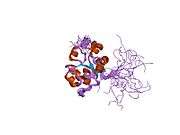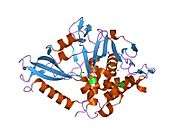USP8
| View/Edit Human | View/Edit Mouse |
Ubiquitin carboxyl-terminal hydrolase 8 is an enzyme that in humans is encoded by the USP8 gene.[3][4][5]
Interactions
USP8 has been shown to interact with RNF41[6] and STAM2.[7][8]
References
- ↑ "Human PubMed Reference:".
- ↑ "Mouse PubMed Reference:".
- ↑ Puente XS, Sanchez LM, Overall CM, Lopez-Otin C (July 2003). "Human and mouse proteases: a comparative genomic approach". Nat Rev Genet. 4 (7): 544–58. doi:10.1038/nrg1111. PMID 12838346.
- ↑ Janssen JW, Schleithoff L, Bartram CR, Schulz AS (May 1998). "An oncogenic fusion product of the phosphatidylinositol 3-kinase p85beta subunit and HUMORF8, a putative deubiquitinating enzyme". Oncogene. 16 (13): 1767–72. doi:10.1038/sj.onc.1201695. PMID 9582025.
- ↑ "Entrez Gene: USP8 ubiquitin specific peptidase 8".
- ↑ Wu, Xiuli; Yen Lily; Irwin Lisa; Sweeney Colleen; Carraway Kermit L (September 2004). "Stabilization of the E3 ubiquitin ligase Nrdp1 by the deubiquitinating enzyme USP8". Mol. Cell. Biol. United States. 24 (17): 7748–57. doi:10.1128/MCB.24.17.7748-7757.2004. ISSN 0270-7306. PMC 506982
 . PMID 15314180.
. PMID 15314180. - ↑ Kaneko, Tomonori; Kumasaka Takashi; Ganbe Tadashi; Sato Takao; Miyazawa Keiji; Kitamura Naomi; Tanaka Nobuo (November 2003). "Structural insight into modest binding of a non-PXXP ligand to the signal transducing adaptor molecule-2 Src homology 3 domain". J. Biol. Chem. United States. 278 (48): 48162–8. doi:10.1074/jbc.M306677200. ISSN 0021-9258. PMID 13129930.
- ↑ Kato, M; Miyazawa K; Kitamura N (December 2000). "A deubiquitinating enzyme UBPY interacts with the Src homology 3 domain of Hrs-binding protein via a novel binding motif PX(V/I)(D/N)RXXKP". J. Biol. Chem. UNITED STATES. 275 (48): 37481–7. doi:10.1074/jbc.M007251200. ISSN 0021-9258. PMID 10982817.
Further reading
- D'Andrea A, Pellman D (1999). "Deubiquitinating enzymes: a new class of biological regulators.". Crit. Rev. Biochem. Mol. Biol. 33 (5): 337–52. doi:10.1080/10409239891204251. PMID 9827704.
- Nomura N, Nagase T, Miyajima N, et al. (1995). "Prediction of the coding sequences of unidentified human genes. II. The coding sequences of 40 new genes (KIAA0041-KIAA0080) deduced by analysis of cDNA clones from human cell line KG-1.". DNA Res. 1 (5): 223–9. doi:10.1093/dnares/1.5.223. PMID 7584044.
- Naviglio S, Mattecucci C, Matoskova B, et al. (1998). "UBPY: a growth-regulated human ubiquitin isopeptidase.". EMBO J. 17 (12): 3241–50. doi:10.1093/emboj/17.12.3241. PMC 1170662
 . PMID 9628861.
. PMID 9628861. - Kato M, Miyazawa K, Kitamura N (2001). "A deubiquitinating enzyme UBPY interacts with the Src homology 3 domain of Hrs-binding protein via a novel binding motif PX(V/I)(D/N)RXXKP.". J. Biol. Chem. 275 (48): 37481–7. doi:10.1074/jbc.M007251200. PMID 10982817.
- Gnesutta N, Ceriani M, Innocenti M, et al. (2001). "Cloning and characterization of mouse UBPy, a deubiquitinating enzyme that interacts with the ras guanine nucleotide exchange factor CDC25(Mm)/Ras-GRF1.". J. Biol. Chem. 276 (42): 39448–54. doi:10.1074/jbc.M103454200. PMID 11500497.
- Strausberg RL, Feingold EA, Grouse LH, et al. (2003). "Generation and initial analysis of more than 15,000 full-length human and mouse cDNA sequences.". Proc. Natl. Acad. Sci. U.S.A. 99 (26): 16899–903. doi:10.1073/pnas.242603899. PMC 139241
 . PMID 12477932.
. PMID 12477932. - Kaneko T, Kumasaka T, Ganbe T, et al. (2004). "Structural insight into modest binding of a non-PXXP ligand to the signal transducing adaptor molecule-2 Src homology 3 domain.". J. Biol. Chem. 278 (48): 48162–8. doi:10.1074/jbc.M306677200. PMID 13129930.
- Soares L, Seroogy C, Skrenta H, et al. (2004). "Two isoforms of otubain 1 regulate T cell anergy via GRAIL.". Nat. Immunol. 5 (1): 45–54. doi:10.1038/ni1017. PMID 14661020.
- Ota T, Suzuki Y, Nishikawa T, et al. (2004). "Complete sequencing and characterization of 21,243 full-length human cDNAs.". Nat. Genet. 36 (1): 40–5. doi:10.1038/ng1285. PMID 14702039.
- Wu X, Yen L, Irwin L, et al. (2004). "Stabilization of the E3 ubiquitin ligase Nrdp1 by the deubiquitinating enzyme USP8.". Mol. Cell. Biol. 24 (17): 7748–57. doi:10.1128/MCB.24.17.7748-7757.2004. PMC 506982
 . PMID 15314180.
. PMID 15314180. - Berruti G, Martegani E (2005). "The deubiquitinating enzyme mUBPy interacts with the sperm-specific molecular chaperone MSJ-1: the relation with the proteasome, acrosome, and centrosome in mouse male germ cells.". Biol. Reprod. 72 (1): 14–21. doi:10.1095/biolreprod.104.030866. PMID 15342353.
- Gerhard DS, Wagner L, Feingold EA, et al. (2004). "The status, quality, and expansion of the NIH full-length cDNA project: the Mammalian Gene Collection (MGC).". Genome Res. 14 (10B): 2121–7. doi:10.1101/gr.2596504. PMC 528928
 . PMID 15489334.
. PMID 15489334. - Benzinger A, Muster N, Koch HB, et al. (2005). "Targeted proteomic analysis of 14-3-3 sigma, a p53 effector commonly silenced in cancer.". Mol. Cell Proteomics. 4 (6): 785–95. doi:10.1074/mcp.M500021-MCP200. PMID 15778465.
- Row PE, Prior IA, McCullough J, et al. (2006). "The ubiquitin isopeptidase UBPY regulates endosomal ubiquitin dynamics and is essential for receptor down-regulation.". J. Biol. Chem. 281 (18): 12618–24. doi:10.1074/jbc.M512615200. PMID 16520378.
- Mizuno E, Kobayashi K, Yamamoto A, et al. (2006). "A deubiquitinating enzyme UBPY regulates the level of protein ubiquitination on endosomes.". Traffic. 7 (8): 1017–31. doi:10.1111/j.1600-0854.2006.00452.x. PMID 16771824.
- Avvakumov GV, Walker JR, Xue S, et al. (2007). "Amino-terminal dimerization, NRDP1-rhodanese interaction, and inhibited catalytic domain conformation of the ubiquitin-specific protease 8 (USP8).". J. Biol. Chem. 281 (49): 38061–70. doi:10.1074/jbc.M606704200. PMID 17035239.
This article is issued from Wikipedia - version of the 6/6/2016. The text is available under the Creative Commons Attribution/Share Alike but additional terms may apply for the media files.




